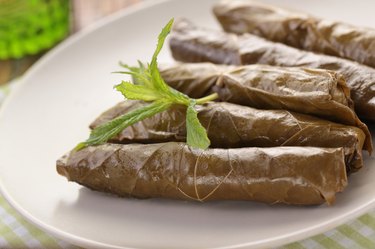
Grape leaves provide vitamins, minerals, antioxidants and fiber. Several studies indicate that grape leaves might help combat memory loss, inflammation and fluid retention, while their antioxidant levels can keep the body young. Grape leaves can be eaten alone or stuffed with ingredients of your choice; traditional fillings include rice, spices and seasonings.
Rich in Good Stuff, Free of Bad Stuff
Video of the Day
Grape leaves contain just 3 calories per leaf, providing low-calorie wrappers for a variety of fillings. They are also free of cholesterol, fat and sodium, and contain vitamins including A, C, E and K, and many B vitamins. Minerals in grape leaves include calcium, iron, potassium and magnesium. Each leaf has about one-third of a gram of fiber, which can easily add up to the recommended 20 to 35 grams per day.
Video of the Day
Skin Beauty
According to a 2010 study from the University of Freiburg in Germany published in the ''Archives of Pharmacal Research,'' eating grape leaves can reduce edema, or fluid retention, in people with chronic venous insufficiency. The research also showed that grape leaves have impressive antioxidant levels that protect the skin from sunburn and sun-induced skin aging. A study that year from Korea's Chungbuk National University showed grape leaves may protect the brain from memory loss, possibly aiding in Alzheimer's prevention.
Inflammation Reduction, Liver Protection
A 2012 study from Okayama University's Graduate School of Medicine, Dentistry and Pharmaceutical Sciences in Japan examined the potential therapeutic effects of grape leaves' water extract, and found it may help reduce inflammation and protect the liver. Specifically, the study highlights the potential for improvement of the liver damage of hepatic fibrosis, or scarring of the liver, as a result of damage. The study also showed grape leaves' ability to reduce oxidative stress and associated inflammation.
Grape Vines as Water Source
Grape stems are not edible; however, the stems may be used as a source of water in an emergency, according to Survival IQ. To access the water, cut the hanging vine at the bottom, and hold the cut end near a container to catch the water. Then, slice the vine on a slant, several feet up the vine. As the water flow slows, you can make cuts farther down the vine as necessary to extract water.
- Survival IQ: Wild Grape Vine
- United States Department of Agriculture, Agricultural Research Service: Basic Report - 11974, Grape Leaves, Raw
- Harvard School of Public Health: Fiber -- Start Roughing It!
- Journal of the German Society of Dermatology: Which Plant for Which Skin Disease? Part 2: Dermatophytes, Chronic Venous Insufficiency, Photoprotection, Actinic Keratoses, Vitiligo, Hair Loss, Cosmetic Indications
- Archives of Pharmical Research: Leaf and Stem of Vitis Amurensis and its Active Components Protect Against Amyloid β Protein (25-35)-Induced Neurotoxicity
- Acta Medica Okayama: Water Extract of Vitis Coignetiae Pulliat Leaves Attenuates Oxidative Stress and Inflammation in Progressive NASH Rats
- What's Cooking America: Stuffed Grape Leaves Recipe, Greek Dolmades Recipe